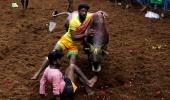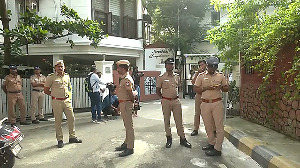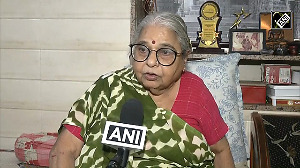They just wanted their angst noticed, and as a symbol of recognition, Jallikattu, restored without the annual ritual of court cases and adjournments, explains N Sathya Moorthy.

Now that a five-judge Constitution bench of the Supreme Court has upheld the Tamil Nadu law on safe practice of Jallikattu, the martial art involving man and animal, there are multiple claimants for its victory.
The then ruling All India Anna Dravida Munnetra Kazhagam, now in the Opposition, and the Bharatiya Janata Party, in power at the Centre then and now, have begun beating the drums, that they and they alone made it happen -- and condemning the rival Dravida Munnetra Kazhagam-Congress combine for causing the ban in the first place, while in power respectively in the state and at the Centre.
It is a fallacy of first, last and all the parts. That is because the unanimously-passed state law, and the reluctant support of the Centre for the same, owed entirely to the Jallikattu protests in the Tamil winter of 2017, marking the harvest festival, Pongal, was an expression of the long pent-up angst of the local people.
The real victory was that of the Tamil youth, who caused and peopled the week-long peaceful protests, the kind of which the nation had not witnessed, then or since -- not certainly after Gandhiji's non-violent freedom movement, decades earlier, in another century.
It was also apolitical and non-political, which cannot be said of the freedom movement. In fact, the protesting youth would not let time-serving politicians join them even for a photo op, and all of them had to stay away.
In comparison, Tamil Nadu's very own anti-Hindi agitation of 1965 was political and violent. The Opposition DMK then spearheaded what otherwise was a students agitation. It became violent, when protestors burnt alive two police officers in different places.
This was apart from their burning down government buses, torching private properties and stoning everything in public view into smithereens across the state for close to six long months. Of course, retaliation by the police caused produced its own long list of casualties from among the agitating youth, students and others.
In more recent times, New Delhi's anti-corruption agitation (2011) and the Nirbhaya protests (2013) against the crude and cruel gang-rape in a running bus, again in the national capital, again took political overtones that also became visible as days rolled by.
In between, there was the anti-foreigners protests that went on for years in Assam, way back in 1979, which resulted in the birth of a new party, which went on to capture electoral power in the north eastern state.
Not any of these with the Jallikattu protests and protestors. The initiators were all faceless youth, mainly with engineering or MBA degrees (or both), mostly working in Indian or MNC corporates in Chennai. They were vexed and frustrated by the way the Centre and the Supreme Court were playing ping-pong with Tamil cultural identity, and also livelihood, on Pongal eve for years -- and that was it.

If Jallikattu personified cultural identity, flowing from the valour of the forebears for generations, the livelihood issue was identified with the Cauvery water dispute with neighbouring Karnataka, which was going on for decades, instead.
In this case, for instance, the P V Narasimha Rao government (1991-1996) at the Centre wanted the higher judiciary to arbitrate the inter-state dispute between Tamil Nadu and Karnataka under the Inter-State River Disputes Act.
In their turn, the learned judges played it back to the government and made it political by asking the prime minister to sort it out with the chief ministers concerned. This was the mood and trend, earlier and later, too, ever since the 1924 bilateral agreement between the British Madras Presidency and the princely state of Mysore, represented now by the Karnataka government, stood dissolved at the end of the originally-agreed 50-year period in 1974.
If this was the case with the Cauvery dispute as it meandered through into the 21st century, when in October-November 2016, months before the Jallikattu protests and more so before the crucial assembly polls in Karnataka, the BJP-ruled Centre told the apex court two different things on two successive days.
On day one, it went by the conventional view that as the final arbiter, the court had to adjudicate on the Cauvery tribunal's final award on water-sharing between the four riparian states, including Kerala and Puducherry.
But on the very next day, the Centre's legal team told the very same Bench in the very same Supreme Court that the judiciary did not have powers to interfere in the matter. Under the law, according to them that fine morning, the Cauvery tribunal was the final authority.
That set the mood and momentum for what was to come but at the level of the individual, without anyone sharing his or her angst with the next person, and without anyone else, both inside the state and outside, noticing it, for them to take note of it, too.
If the politicos and more so farmers in Tamil Nadu felt that the sudden U-turn owed to the BJP's electoral calculations for Karnataka, and nothing more. That snapped something inside them, more so than even the imposition of Hindi decades ago. Still, the world was oblivious.
When this was followed by the Supreme Court, once again, going up and down with its approach to the long-pending Jallikattu case, the 'message was clear' -- or, that is what the urbanised rural youth from the previous decade had concluded, with their access to more information and interpretations, at the touch of a few keys on their computers and mobiles. They thought and felt like the other, because that was also the kind of exposure each one of them had got individually.
This is also where socio-economic transformation of the 'Dravidian kind' did its tricks -- but from the days of the then Congress chief minister K Kamaraj in the mid-fifties. Yesteryear rural youth, who had toiled with their parents in their small plots of farming land, whether from the delta or elsewhere, were today's software engineers and middle-management executives, in top corporates in Chennai and elsewhere in the state, many outside the state and also the country.
What was also common to this generation was that unlike the previous generation of urban and caste elite who had migrated mostly to the West, never to return, these ones still maintained live contacts with folks back home.
Invariably every such conversation, almost every morning, began with the simple question: 'How is the crop this season? Rain, shine...'
This, the antagonists of the Tamil sentiments up north, who had bracketed them all under the prejudiced Dravidian tag, would never ever be able to touch and feel. But the reverse is also equally true, and may be even more, at times.
Without even knowing that the socio-economic dynamics across the Vindhyas had changed, almost for good -- and it was their perceptions that needed changing, the elite elsewhere were reacting to a set of worn-out, unproved assumptions about 21st century Tamil Nadu.
It was the cumulative effect of the Centre's U-turn on the Cauvery issue and the annual ritual of the Supreme Court taking up the Jallikattu case only a week before each season and okaying it for the moment that caused the youth's suspicions, grounded as they were in things Tamil.

So, when the first set of social media messages went one Sunday morning in January 2017 for people to gather at the famed Marina beach in Chennai, the state government and city police were both caught napping.
But when reports came in later in the day that anything up to 20,000 people, especially youth of either gender, some with infants in hands, had gathered on the Marina sands, it became clear that they were not there as week-end beach-goers.
The next weekend it saw a similar exercise in southern temple town of Madurai, central to the annual Jallikattu fete in villages like Avuniyapuram, Alanganallur and Palamedu in the neighbourhood, and in a few other towns, that people started taking note even more.
When this was followed by the real thing, again in Marina, another Sunday ahead, then the emotional floodgates broke loose in every Tamil.
Come the second day, and the protest had spread across towns and villages, and to places down south, where the Cauvery waters did not flow and Jallikattu had never been seen only on the silver screen, in yesteryear movies like Thaaikkuppin Thaaram (1956) and Veerapandia Kattabomman (1969), Murattu Kaalai (1980) and Virumandi (2004), and a host of others.
Critics even used this exemption to attribute motives to the protests. They never saw that even in these towns and villages, the people felt the angst as a part of the larger impediment to the Tamil livelihood and 'wanton insult' to 'Tamil culture'.
At its peak, about a million people, not all of them young, gathered there at the Marina. Even on lean nights, at least a lakh of them, mostly youth and of both genders, stayed put, with the sky providing the only canopy and mobile phones providing the only light.
Unless in the interior towns and villages, where parents and brothers joint the protests with their younger siblings, both boys and girls, in the vast and open spaces of the Marina, there was nothing to fear from each other, or one another.
It soon became a community event, as onlookers brought with them food and snacks, and even drinking water to the protestors. Homes near the protest venue opened their doors, especially for the female protestors, to rest and relax.
It was the closest to the 'Arab Spring' or 'Orange Revolution' elsewhere, but there were no calls for 'Tamil separatism', nor for the overthrow of a government, whether in the state or at the Centre -- as some critics, both inside the state and more so outside the state, had expected/anticipated.
They just wanted their angst noticed, and as a symbol of recognition, Jallikattu, restored without the annual ritual of court cases and adjournments.
Yes, there was violence involving the police and a residual group of protestors who refused to leave the Marina site, for the authorities to prepare the ground for the Republic Day parade the next day, but they had an agenda. No one other than this group and also a section of the political class protested.
To date, most organisers have melted into society, not because they are afraid of police reprisals but because they were keen only about sending out their message, not promoting themselves. And that is also the highest point in the Jallikattu protests, as no one bothered planning annual celebrations for their victory in the subsequent years.
For them, the return of Jallikattu was victory enough, and none of them needed a free ride of the Arvind Kejriwal/Kiren Bedi kind, after the successful 2011 'Team Anna' protests in Delhi and elsewhere.

Now that the court verdict is out there, PETA and other petitioners/appellants would still be looking for infringements of the court-approved laws, to report back. Then, there is the one question that the court left hanging on the 'cultural antiquity' of Jallikattu.
It is not known if the state's lawyers did not address this issue adequately, because some of them too might not have understood the significance of it all, to be able to appreciate their evidentiary value.
If one acknowledges that the Sangam literature is 2,000 years old, and that would be an authentic cultural-marker, then you have references to it in Kalithogai and Porunaraarthu-p-padai.
It is especially in the section Mullai-Kali, pertaining to pastoral lands and people, that poet Nallanthuvanar, details Jallikattu, or Eru Thazhuvuthal, as he too had referred to it, in 350 lines of poetry.
And over a thousand and more years later, in the 14th century, Nachchinarkiniyar, in his commentary on Kalithogai, provides it was a continuing tradition. A tradition, in which the thalaivan (protagonist or hero) has to untie the cloth with a challi, or coin, tied (kattu) to the horns of a trained and raging bull, to take the hands of the thalaivi, or the heroine.
Only that challi became jalli and challikattu became Jallikattu, but the culture and tradition have remained the same, though going speedily out of practice, until the Jallikattu protests possibly saved the day.
N Sathiya Moorthy is the author of Jallikattu: A Symbol Of Tamil Angst (Vitasta)., Vitasta, 2018.










